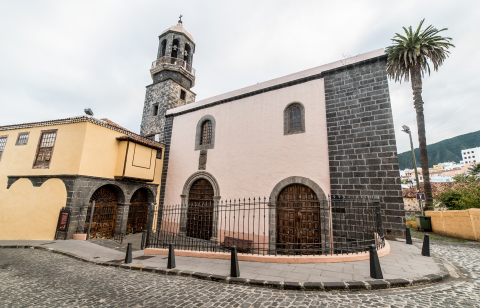3. Santo Domingo church

This church was inaugurated towards the end of the 17th century by the Dominicans. The Dominican order was very important in Spain between the 16th and 19th centuries. This order saw poverty as a way of being closer to God. You can find this religious order’s coat of arms on the façade: a dog bearing a torch, symbolising the faith that illuminates the world.
The exterior of this pocket-sized church, which is attached to a convent, stands out due to the width of its the bell tower. Inside you can find a wonderful range of Mudejar ceilings. This is because wealthy families independently built numerous chapels that were later merged together. The variety of shapes and dimensions of the coffered ceilings covering both the naves and the side chapels make it a unique place in the Canary Islands. The carvings and paintings from different periods kept here are also of great interest.
Tunnels, crypts and ossuaries were uncovered here during the church’s restoration in the 1980s. There was speculation that La Orotava’s old convents, and even the Church of the Conception, were connected via underground passages.
When La Orotava was founded, it had five convents, two for females and three for males. La Orotava’s richest families funded various religious orders, and disputes among the orders were commonplace to gain the favour of benefactors during the 17th and 18th centuries.
The idea of connecting tunnels fed the legend of an underground world where the true relations between convents took place, hidden away from the rest of the town.
Even though the theory didn’t really hold fast, there was some truth to it: the convents used to have tunnels and crypts, but they did not connect to one another. Even so, theory defenders continue to argue to this very day that the connections were buried under the current buildings, water pipes and electricity cables.
Let’s go down the street now towards the entrance of the former convent, which is today the Spanish-American Craft Museum.
